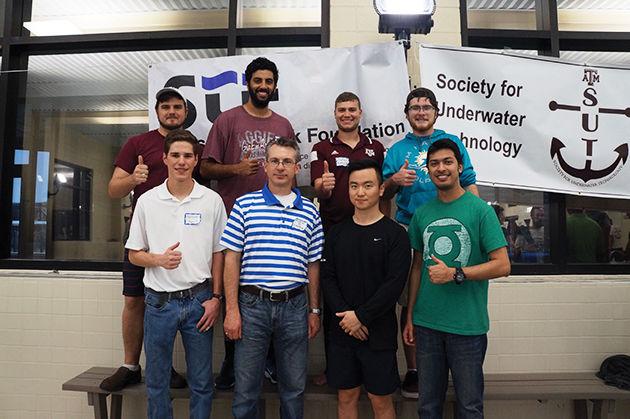Students operated robots through underwater obstacle courses and designed buoyant devices at the Recreational Pool Center Saturday as part of a Remotely Operated Vehicle competition.
The Remotely Operated Vehicle, or ROV, competition was hosted by The Society for Underwater Technology at Texas A&M and the Subsea Tieback Foundation and enabled students to get a glimpse of offshore engineering through simulated, real-world scenarios. Each randomized team was assigned a mentor with experience in the offshore industry and competed in three activities that involved maneuvering ROVs to adapt to various environmental conditions.
Don Wells, chairman of the Subsea Tieback Foundation, said students were challenged in multiple ways from communications and find viable solutions within a given time constraint and instructions just like in the industry of offshore engineering.
“It is a learning opportunity in like that it is like real life,” Wells said. “We gave them purposely vague instructions and said start now, you get 20 minutes … When we get together at the end, we will compare to see why the team performed the way they did. They are getting to see failure in a learning experience which we do all the time in industry. We are letting them witness this in a prime atmosphere.”
Hannah Toerner, ocean engineering junior and participant, said the competition made her realize the importance about communication with other teammates and learning from their mistakes.
“It hurt to be the first group but also helped,” Toerner said. “At first we were having a hard time communicating because we were all on different sides and everyone was shouting different things, but it got better as we went on. In our classes, you learn about all this technology but you rarely get to put it to use and they just throw you into the real telling you to use it.”
Chukwuemeka Obi, subsea engineering graduate student and president of Texas A&M Society for Underwater Technology, said he was inspired to do this event because he wanted to help students gain valuable experience they may use one day.
“The underwater obstacle course was created to imitate the challenges that the ROV pilots would face when taking something from point A to point B,” Obi said. “When you are working as an ROV pilot in 10 thousand feet of water, you cannot see anything, so you have to rely on the people around you and the control screens — like they got to do today.”
Mohammad Khan, industrial engineering junior and member of the winning team, said they worked effectively as a group and were very open minded to everyone’s ideas.
“I think the reason why I thought we were going to win was the team chemistry we all had,” Khan said. “None of us stepped up and were like we are doing this. We all accepted each other’s ideas and collaborate and build upon them. We also credit to our excellent ROV driving to the many hours of playing video game. I really enjoyed with these guys.”
Patricia Varela, a civil engineering Ph.D. student, founding member of the Society for Underwater Technology and a judge for the competition, said this event and chapter at Texas A&M is focused on the collaboration between students from different backgrounds and fields to test how they would work in the real world.
“The mission statement is to connect people from different disciplines and get them to work together,” Varela said. ”If you ask people from each team, you will see people from different departments and you will see them working together. Each one of them will be able to provide their own sets of skills and leadership and not necessarily technical, but in terms of communicating and working with a team, it is as important and the technical part.”
Garrett Malatek, mechanical engineering freshman and member of the winning team, said this event was a great model of what the industry required of them in terms of resources used and wasted.
“Essentially it is a great model for real world examples because when you have the real subsea industry, you can’t afford to waste energy by continuously adjusting your buoyancy,” Malatek said. “That is essentially what they are trying to hammer into our heads right now so we can achieve natural buoyancy without wasting resources and that really is what we learned here today.”
Aggies compete in underwater tech contest
March 5, 2017
Photo by Photo by Maria Fuentes
Pictured above are the winners of Texas A&M’s first-ever collegiate ROV competition.
0
Donate to The Battalion
$2065
$5000
Contributed
Our Goal
Your donation will support the student journalists of Texas A&M University - College Station. Your contribution will allow us to purchase equipment and cover our annual website hosting costs, in addition to paying freelance staffers for their work, travel costs for coverage and more!
More to Discover










